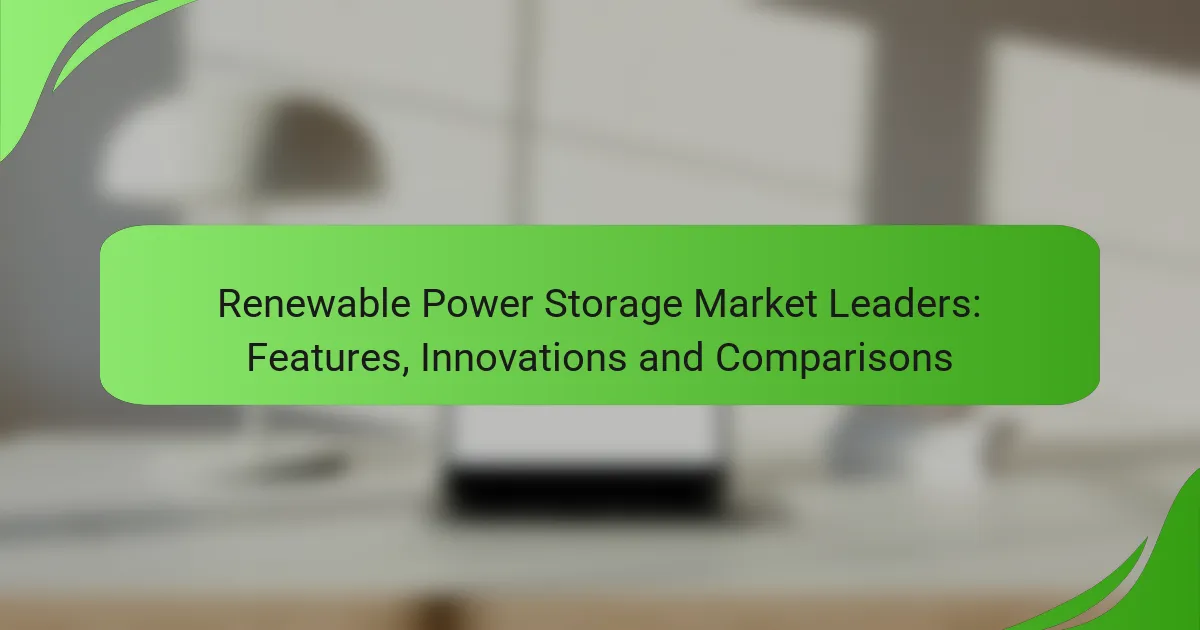The renewable power storage market is characterized by a diverse range of technologies, including lithium-ion batteries, pumped hydro storage, and flow batteries, each offering unique advantages for various applications. Major players like Tesla, LG Chem, and Siemens are at the forefront, providing innovative solutions that cater to different consumer needs. Recent advancements in battery technology and smart grid integration are driving efficiency and cost reduction, enhancing the reliability of renewable energy sources.
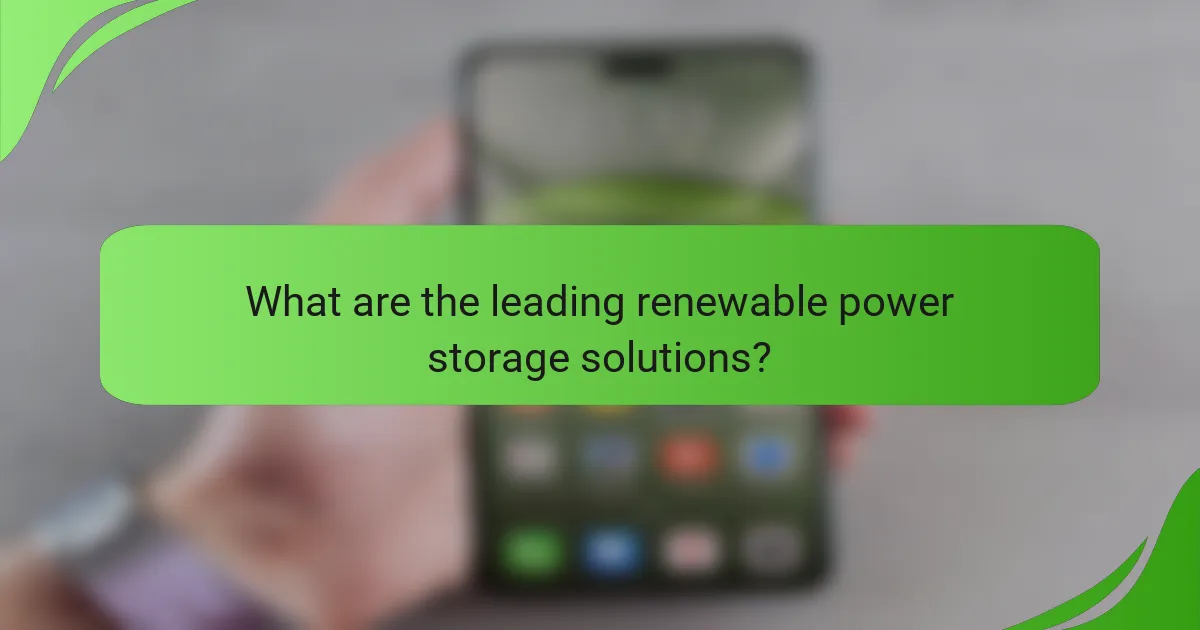
What are the leading renewable power storage solutions?
The leading renewable power storage solutions include lithium-ion batteries, pumped hydro storage, flow batteries, compressed air energy storage, and solid-state batteries. Each of these technologies offers distinct advantages and trade-offs, making them suitable for various applications in the renewable energy landscape.
Lithium-ion batteries
Lithium-ion batteries are widely used for energy storage due to their high energy density and efficiency. They work by moving lithium ions between the anode and cathode during charging and discharging, allowing for quick energy release and recharge cycles.
These batteries are ideal for applications such as electric vehicles and grid storage, with typical lifespans ranging from 5 to 15 years. However, they can be expensive and may require careful thermal management to prevent overheating.
Pumped hydro storage
Pumped hydro storage is a mature technology that uses two water reservoirs at different elevations. During periods of low energy demand, excess electricity is used to pump water uphill; during peak demand, the stored water is released to generate electricity.
This method can provide large-scale energy storage, with capacities often exceeding hundreds of megawatts. While it is cost-effective over long periods, the need for suitable geographical locations can limit its implementation.
Flow batteries
Flow batteries store energy in liquid electrolytes contained in external tanks, allowing for scalable energy storage solutions. They can be charged and discharged simultaneously, making them suitable for applications requiring long-duration energy storage.
These batteries typically have longer lifespans compared to lithium-ion batteries and can be more easily scaled up. However, they tend to have lower energy density, which can make them less suitable for mobile applications.
Compressed air energy storage
Compressed air energy storage (CAES) involves compressing air in underground caverns or tanks during low-demand periods and releasing it to drive turbines for electricity generation during high-demand periods. This method can store large amounts of energy and is particularly useful for balancing intermittent renewable sources like wind and solar.
CAES systems can have high capital costs and require specific geological formations for optimal implementation. However, they can provide significant grid stability and energy management benefits.
Solid-state batteries
Solid-state batteries utilize solid electrolytes instead of liquid ones, which can enhance safety and energy density. They promise longer lifespans and faster charging times compared to traditional lithium-ion batteries.
While still in the development phase for many applications, solid-state batteries could revolutionize energy storage in electric vehicles and stationary applications. Their higher manufacturing costs and current scalability challenges are important considerations for future adoption.

How do major companies compare in renewable power storage?
Major companies in the renewable power storage market vary significantly in technology, capacity, and application. Key players like Tesla, LG Chem, Siemens, and General Electric each offer unique features that cater to different consumer needs and market segments.
Tesla’s Powerwall vs. LG Chem
Tesla’s Powerwall is known for its sleek design and integration with solar energy systems, offering a storage capacity of around 13.5 kWh. It is ideal for residential use, providing backup power and energy management through its smart technology.
In contrast, LG Chem’s RESU series offers various models with capacities ranging from 6.5 kWh to 16 kWh, catering to both residential and commercial applications. LG Chem’s batteries are recognized for their high energy density and efficiency, making them a strong competitor in the market.
Siemens vs. General Electric
Siemens focuses on large-scale energy storage solutions, including lithium-ion and flow batteries, suitable for grid stabilization and renewable integration. Their systems are designed for commercial and industrial applications, providing flexibility and scalability.
General Electric, on the other hand, emphasizes hybrid systems that combine renewable generation with storage. Their technologies aim to enhance grid reliability and reduce operational costs, appealing to utility companies and large enterprises.
Fluence vs. AES Energy Storage
Fluence, a joint venture between Siemens and AES, specializes in energy storage technology for utility-scale projects. Their solutions are designed for rapid deployment and can be tailored to meet specific grid requirements, making them a leader in large-scale applications.
AES Energy Storage offers a range of solutions, including the Advancion platform, which focuses on optimizing energy storage for renewable integration. Their systems are known for advanced analytics and operational efficiency, providing utilities with reliable and cost-effective storage options.
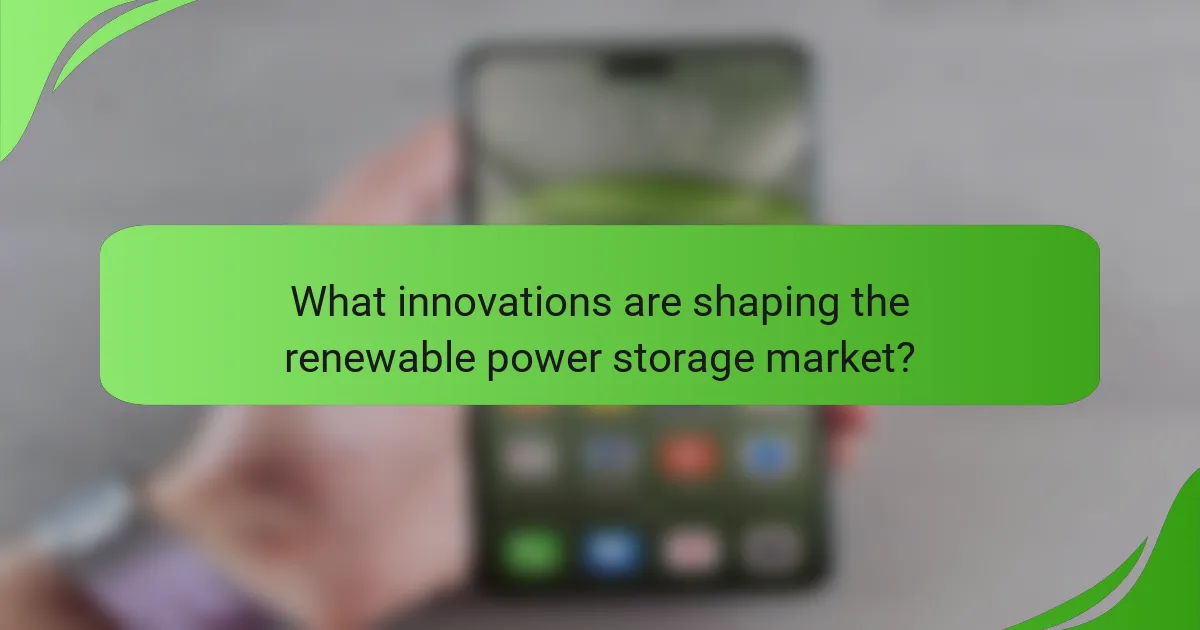
What innovations are shaping the renewable power storage market?
Innovations in the renewable power storage market are primarily driven by advancements in battery technology, integration with smart grid systems, and the application of artificial intelligence in energy management. These developments enhance efficiency, reduce costs, and improve the overall reliability of renewable energy sources.
Advancements in battery chemistry
Recent advancements in battery chemistry, such as the development of solid-state batteries and lithium-sulfur technologies, are significantly improving energy density and safety. These new chemistries can potentially offer higher capacities and longer lifespans compared to traditional lithium-ion batteries.
For instance, solid-state batteries can achieve energy densities exceeding 300 Wh/kg, which is a substantial improvement over conventional batteries. This increase allows for more compact storage solutions that are crucial for electric vehicles and grid applications.
Integration with smart grids
Smart grid integration is transforming how renewable energy is stored and distributed. By utilizing real-time data and advanced communication technologies, smart grids can optimize energy flow and storage based on demand and supply conditions.
For example, energy storage systems can be charged during off-peak hours when electricity is cheaper and discharged during peak demand, providing cost savings and enhancing grid stability. This dynamic interaction can lead to a more resilient energy infrastructure.
AI in energy management
The incorporation of artificial intelligence in energy management systems is revolutionizing the renewable power storage landscape. AI algorithms can analyze vast amounts of data to predict energy usage patterns, optimize storage schedules, and enhance overall system efficiency.
By leveraging AI, energy providers can make informed decisions about when to store energy and when to release it, maximizing the use of renewable sources. This technology not only improves operational efficiency but also contributes to reducing greenhouse gas emissions by optimizing the use of clean energy.
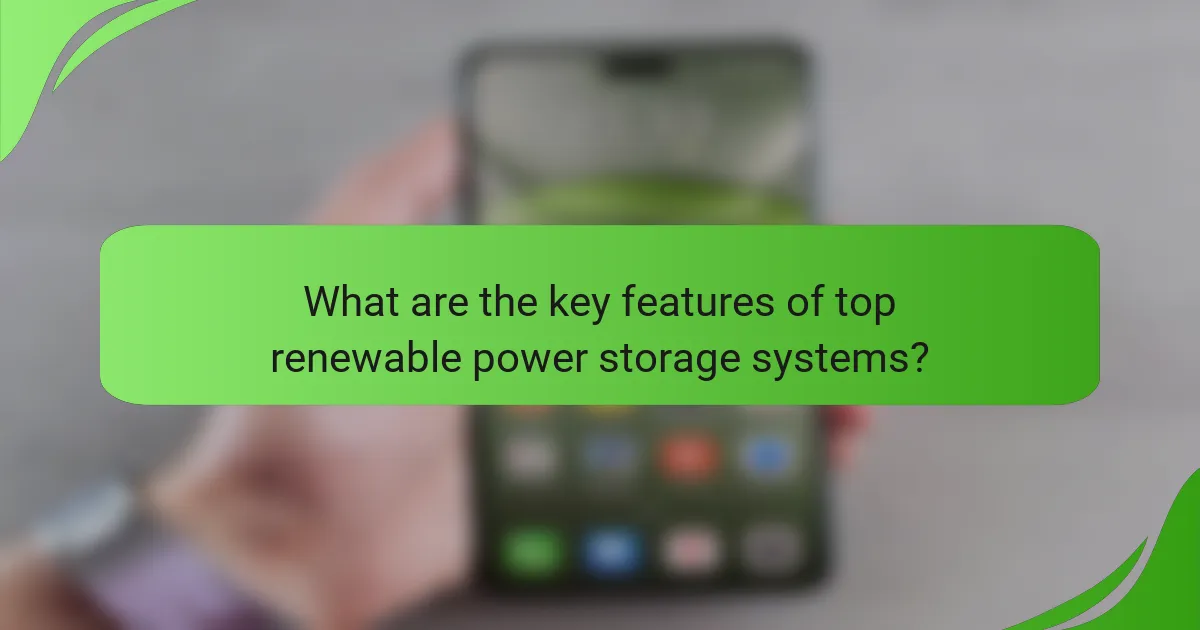
What are the key features of top renewable power storage systems?
Top renewable power storage systems are characterized by their energy capacity, efficiency ratings, and lifecycle durability. These features determine how effectively they can store and deliver energy, impacting their overall performance and suitability for various applications.
Energy capacity
Energy capacity refers to the total amount of energy a storage system can hold, typically measured in kilowatt-hours (kWh). Leading systems can range from several kilowatt-hours for residential applications to megawatt-hours for commercial and utility-scale solutions. When selecting a system, consider your energy needs and how often you will need to draw from the storage.
For example, a home battery system might have a capacity of 10-15 kWh, sufficient for daily use, while larger installations may exceed 1,000 kWh to support industrial operations or grid stabilization. Understanding your energy consumption patterns is crucial for choosing an appropriate capacity.
Efficiency ratings
Efficiency ratings indicate how much of the stored energy can be effectively used after accounting for losses during charging and discharging. Most modern systems boast efficiencies between 80% and 95%. Higher efficiency means less energy is wasted, making the system more cost-effective over time.
When evaluating efficiency, look for systems that meet or exceed industry standards, such as those set by the International Electrotechnical Commission (IEC). Additionally, consider the round-trip efficiency, which measures the total energy lost in the process of storing and retrieving energy.
Lifecycle and durability
The lifecycle of a renewable power storage system refers to its operational lifespan, typically measured in charge cycles. High-quality systems can last anywhere from 5 to 15 years, depending on usage and technology. Lithium-ion batteries, for instance, often provide a longer lifecycle compared to lead-acid alternatives.
Durability is also crucial, as it affects the system’s ability to withstand environmental conditions and operational stresses. Look for systems with robust warranties and proven performance in various climates. Regular maintenance can further enhance durability and extend the lifecycle of your storage solution.
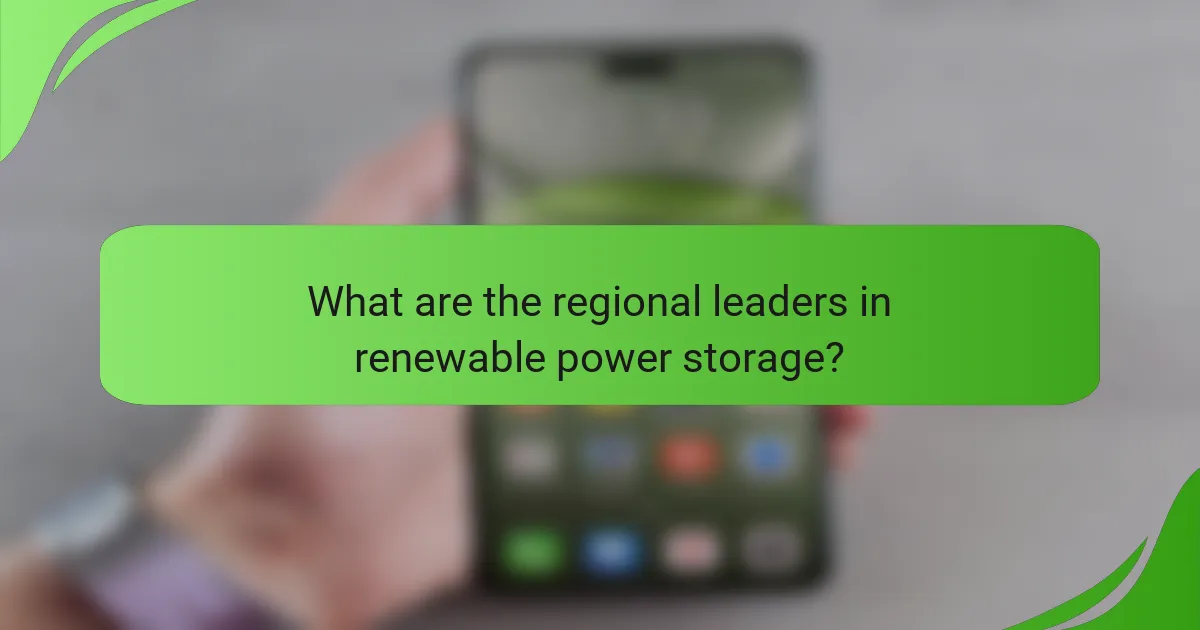
What are the regional leaders in renewable power storage?
The regional leaders in renewable power storage include North America, Europe, and Asia-Pacific, each showcasing unique innovations and market dynamics. These regions are at the forefront of developing technologies that enhance energy storage capabilities, addressing the growing demand for sustainable energy solutions.
North America
North America, particularly the United States, leads in renewable power storage with a focus on lithium-ion battery technology. Companies like Tesla and LG Chem are key players, driving advancements in battery efficiency and scalability. The region benefits from supportive policies and substantial investments, making it a hub for innovation in energy storage systems.
In addition to lithium-ion, North America is exploring alternative technologies such as flow batteries and compressed air energy storage. These options provide longer-duration storage solutions, which are essential for balancing intermittent renewable sources like solar and wind.
Europe
Europe is a strong contender in the renewable power storage market, with countries like Germany and the Netherlands leading the charge. The European Union has implemented ambitious regulations and incentives to promote energy storage, fostering a competitive environment for companies like Siemens and Varta. The focus is on integrating renewable energy sources into the grid efficiently.
Innovations in Europe include the development of smart grids and energy management systems that optimize storage use. Additionally, the region is investing in hydrogen storage technologies, which hold promise for long-term energy storage and grid stability.
Asia-Pacific
Asia-Pacific, particularly China, is rapidly emerging as a leader in renewable power storage, driven by significant government support and investment. China dominates the global battery manufacturing market, with companies like CATL and BYD leading in production capacity and technology advancements. The region’s focus on renewable energy integration is reshaping its energy landscape.
In addition to battery storage, Asia-Pacific is exploring innovative solutions such as pumped hydro storage and thermal energy storage. These technologies are crucial for managing the increasing share of renewables in the energy mix, ensuring reliability and efficiency in power supply.
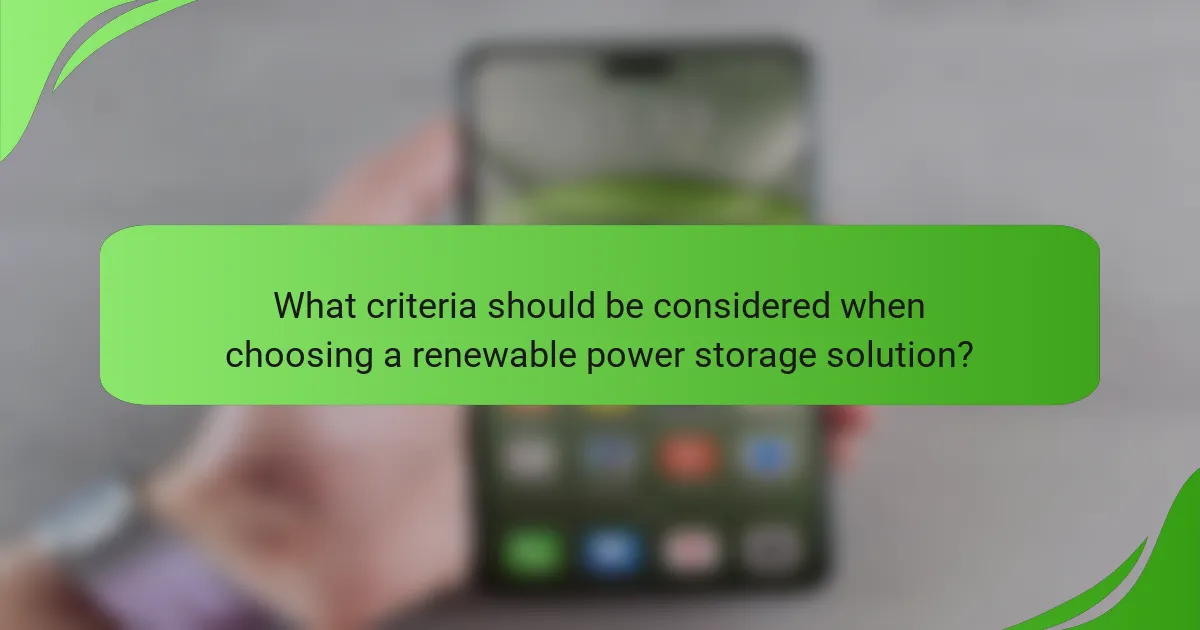
What criteria should be considered when choosing a renewable power storage solution?
When selecting a renewable power storage solution, consider factors such as capacity, efficiency, lifespan, and cost. These criteria will help determine the best fit for your energy needs and budget.
Capacity
Capacity refers to the amount of energy a storage system can hold, typically measured in kilowatt-hours (kWh). It’s crucial to assess your energy consumption patterns to choose a system that meets your peak demand without excessive oversizing.
For instance, a household that consumes around 30 kWh daily might require a storage solution with a capacity of at least 10-15 kWh to ensure sufficient backup during outages or low production periods.
Efficiency
Efficiency indicates how much energy is retained after storage and retrieval, usually expressed as a percentage. Higher efficiency means less energy loss, which is vital for maximizing the benefits of renewable sources.
Look for systems with round-trip efficiencies above 80%, as this ensures that most of the stored energy is usable. Lithium-ion batteries, for example, often achieve efficiencies in the 90% range.
Lifespan
The lifespan of a storage solution is essential for long-term investment. It is typically measured in charge cycles, with many systems lasting anywhere from 5 to 15 years or more, depending on the technology used.
Consider the warranty and expected cycle life when evaluating options. For example, some lithium-ion batteries may offer warranties for 10 years or 5,000 cycles, providing a clearer picture of their longevity.
Cost
Cost encompasses both the initial investment and ongoing maintenance expenses. Evaluate the total cost of ownership, including installation, operation, and potential incentives or rebates available in your region.
Prices for storage systems can vary widely, with residential solutions ranging from a few thousand to over ten thousand USD. Be sure to factor in local incentives, which can significantly reduce upfront costs.
